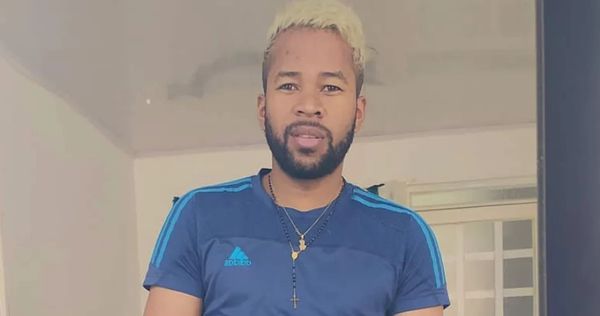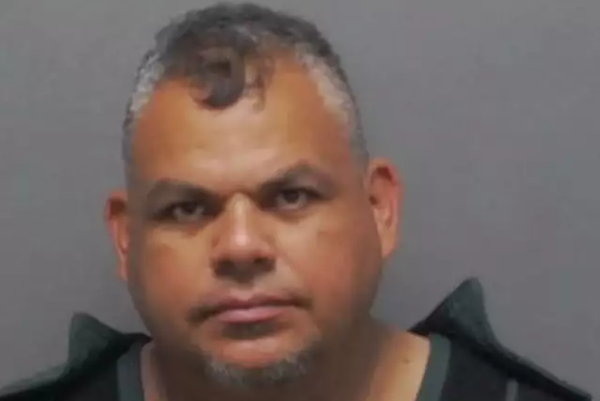
Gyasi Mitchell’s acceptance of therapy and support for his depression began with an invitation to a park. Mitchell, 22, was lying in bed in a youth shelter in South Los Angeles. He heard Moises Rodriguez, a counselor, in the hallway outside his room announcing that a therapeutic exercise session was going to start across the street, at the South Park Recreation Center. Mitchell went to the park and joined a pickup basketball game with others from the shelter.
The other ballers were like him — unhoused, young men; mostly Black and Latino. Conversation ran shallow, Mitchell said — “What’s Up? What’s good?” — but there was a deeper sense of nonjudgement to being there. Mitchell called it “showing up for one another.”
“Everytime I play, I always leave better,” Mitchell said. “But it goes further than that. You’re letting someone know you’re there for them, if they need to talk, [receive] comfort or advice.”
When he moved to another shelter in Hollywood, Mitchell continued to play basketball as a way to release pent-up aggression and connect with his peers.
Ballers told Mitchell they were getting a lot out of therapy sessions in the shelter. Their recommendation got Mitchell to give therapy a try — something he had been avoiding before.
Through therapy Mitchell started to learn to manage the inner anger and sadness that he described as “crippling,” causing him to linger in bed throughout the day, unmotivated and sometimes even thinking about suicide. Mitchell’s journey to trust his peers and a therapist illustrates how young people are finding mental health support on their own terms — not being told what to do by family members or insurance companies.

Youth continue to report high rates of anxiety — 29% nationwide and 58% in California — and depression — 40% nationwide and 54% in California. Through the Children and Youth Behavioral Health Initiative, which launched in 2021, the state is investing $4.6 billion over a five year period to improve mental health support and access for young people. That includes trauma-informed training for teachers, digital apps offering direct access to therapists and easier billing and invoicing for therapists who offer their services at public schools. A series of 50 youth forums across California in 2022 revealed what young people themselves want: peer support; choice in their mental health support and treatment; and therapists who share their experiences and culture.
Mitchell said that in 2008, when he was 6, he began to experience what he calls debilitating depression — the inability to get out of bed and suicidal thoughts. Mitchell cannot point to a single cause, though he notes he was aware of growing tension between his parents that led to their eventual separation last year. His father works as an urban farmer and chef at a celebrated Baltimore restaurant; his mother is a registered nurse at a West Baltimore hospital. Mitchell said his family had the means to afford family therapy for him and his four siblings.
But Mitchell didn’t trust the therapist the family saw nor the process: He had no say in whether to attend therapy nor in who he would talk to. He also didn’t trust sharing his feelings with his family — specifically fearing his father would be dismissive. Mitchell didn’t know what the therapist would do with what he shared — he didn’t want to be labeled or given a prescription for medication. With these concerns, Mitchell didn’t speak during therapy. After a few sessions without him participating, Mitchell said the family stopped going.
Mitchell’s journey to trust mental health professionals began in 2023, during a year off from New York University. Mitchell had just finished his third year as a film major; he said he was unhappy with his life. He joined an educational program to work on an organic farm in upstate New York that fall. Three weeks later, Mitchell found his way to the Hiranyagarbha Yuga Ashram, a spiritual commune, in Virginia’s Blue Ridge Mountains. There he worked in the garden and farm, built housing, cooked and meditated. At the ashram, a friend suggested he could visit Los Angeles and stay with his family in Studio City.

Mitchell bought a one-way plane ticket and landed in Los Angeles on Jan. 10. For about a month, he lived with the family of the friend from the ashram. He said he was comfortable there, but he felt he wanted to roam. He chose to live on the streets — saying he was following his heart and intuition — hiding out in La Cienega Park in Beverly Hills that February. Neighborhood residents who had seen him in the park and figured out he was unhoused connected Mitchell with the Beverly Hills Outreach Team, which assists unhoused residents find shelter. For Mitchell, they found a space in a youth transitional shelter.
Before the month ended, he would celebrate his birthday at Home at Last, a youth shelter in South Los Angeles. After three months, Mitchell had the choice to extend his stay there. He chose to move to Covenant House, a shelter in Hollywood.
At Covenant House, Mitchell again saw Moises Rodriguez, the counselor who had brought Mitchell into the basketball game in South Los Angeles. It turned out Rodriguez ran another game there. Mitchell joined that game, where he was told about the therapist at Covenant House.
Mitchell saw her every Tuesday. She didn’t treat him like a problem to be solved by slowly chipping away with questions, Mitchell recalled. She listened to him. In late August, the therapist formally diagnosed Mitchell with severe depression and anxiety. It was just a few days before he was to fly back to Baltimore, as his gap year was ending and he needed to return to NYU. The diagnosis helps, Mitchell said, qualifying him for an emotional support animal. He said he plans to get a dog because they’re full of life and he loves their energy.
Now back at NYU, Mitchell calls the past year hard and dark. His story shows that the path by which reluctant youths can come to trust mental health support begins at the same point: by finding peers with common challenges and therapists who listen to what young people say they need.
This article was produced as a project for the USC Annenberg Center for Health Journalism’s 2024 California Health Equity Fellowship.
Copyright 2024 Capital & Main.
All photos by Isabel Avila.







